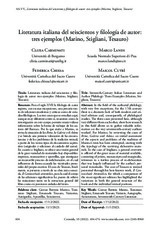Mostrar el registro sencillo del ítem
Literatura italiana del seiscientos y filología de autor: tres ejemplos (Marino, Stigliani, Tesauro)
| dc.contributor.author | Carminati, Clizia | |
| dc.contributor.author | Landi, Marco | |
| dc.contributor.author | Chiesa, Federica | |
| dc.contributor.author | Cutrì, Maicol | |
| dc.date.accessioned | 2023-07-20T09:43:51Z | |
| dc.date.available | 2023-07-20T09:43:51Z | |
| dc.date.issued | 2022 | |
| dc.identifier.issn | 2340-8960 | |
| dc.identifier.uri | http://hdl.handle.net/10396/25790 | |
| dc.description.abstract | Para el siglo XVII la filología de autor registra, con escasas excepciones, una penuria tanto de ediciones modernas y críticas como de estudios filológicos. Los tres casos que se estudian aquí, aunque muy diferentes entre sí, muestran cómo la investigación en este campo permite reunir valiosa información sobre la forma de trabajar de los autores del Barroco. Por lo que atañe a Marino, se revisa la situación de las Rime, la Galeria y el Adoney se brinda una primera valoración de las circunstancias y de los problemas de la tradición textual, a partir de los varios tipos de documentos supérstites (originales y ediciones al cuidado del autor). En cuanto a Stigliani, se ofrece una visión general de la gran variedad de materiales hoy disponibles: impresos, manuscritos y apostillas, que atestiguan un incansable proceso de reelaboración, en el cual influyeron de forma acusada las vicisitudes personales del propio escritor. El caso de Tesauro, final-mente, se presenta a través de su obra más conocida, Il Cannocchiale aristotelico, para la cual el cotejo de las ediciones significativas ha puesto de relieve las variaciones tanto en la estructura general del libro como en porciones aisladas del texto. | es_ES |
| dc.description.abstract | In the field of the authorial philology, with very few exceptions, for the 17th century there is a dramatic lack of both modern and critical editions and, consequently, of philological studies. The three cases presented here, although very different from each other, show how research in this field allows us to gather valuable information on the way seventeenth-century authors worked. For Marino, by reviewing the cases of Rime, Galeria and Adone, an initial assessment of the aspects and problems of the tradition of Marino’s texts has been attempted, starting with the typology of the surviving elaborative materials. In the case of Stigliani, a general overview is offered of the great mass of material available, consisting of prints, manuscripts and marginalia, witnesses to a tireless process of re-elaboration that was largely influenced by the author’s personal vicissitudes. The case of Tesauro is instead presented through his best-known work, Il Cannocchiale Aristotelico, for which a comparison of the most significant editions has highlighted the variations in both the general structure of the book and the individual textual portions. | es_ES |
| dc.format.mimetype | application/pdf | es_ES |
| dc.language.iso | spa | es_ES |
| dc.publisher | UCOPress | es_ES |
| dc.rights | https://creativecommons.org/licenses/by-nc-nd/4.0/ | es_ES |
| dc.source | Creneida 10, 404-474 (2022) | es_ES |
| dc.subject | Giovan Battista Marino | es_ES |
| dc.subject | Tommaso Stigliani | es_ES |
| dc.subject | Emanuele Tesauro | es_ES |
| dc.subject | Variantes | es_ES |
| dc.subject | Autógrafos | es_ES |
| dc.subject | Apostillas | es_ES |
| dc.subject | Seiscientos | es_ES |
| dc.subject | Variants | es_ES |
| dc.subject | Autographs | es_ES |
| dc.subject | Annotations | es_ES |
| dc.subject | Seventeenth-Century Literature | es_ES |
| dc.title | Literatura italiana del seiscientos y filología de autor: tres ejemplos (Marino, Stigliani, Tesauro) | es_ES |
| dc.title.alternative | Sixteenth-Century Italian Literature and Author Philology: Three Examples (Marino, Stigliani, Tesauro) | es_ES |
| dc.type | info:eu-repo/semantics/article | es_ES |
| dc.relation.publisherversion | http://www.uco.es/servicios/ucopress/ojs/index.php/creneida/index | es_ES |
| dc.rights.accessRights | info:eu-repo/semantics/openAccess | es_ES |

